Understanding music genres is essential for appreciating the complexity of contemporary music. This article explores the classification of genres, their evolution through cultural shifts, and the impact of cross-genre influences. It examines current trends, such as the rise of lo-fi hip hop and K-pop, and discusses the challenges artists face in navigating genre fluidity. Additionally, it highlights how these genres shape listener experiences and preferences.
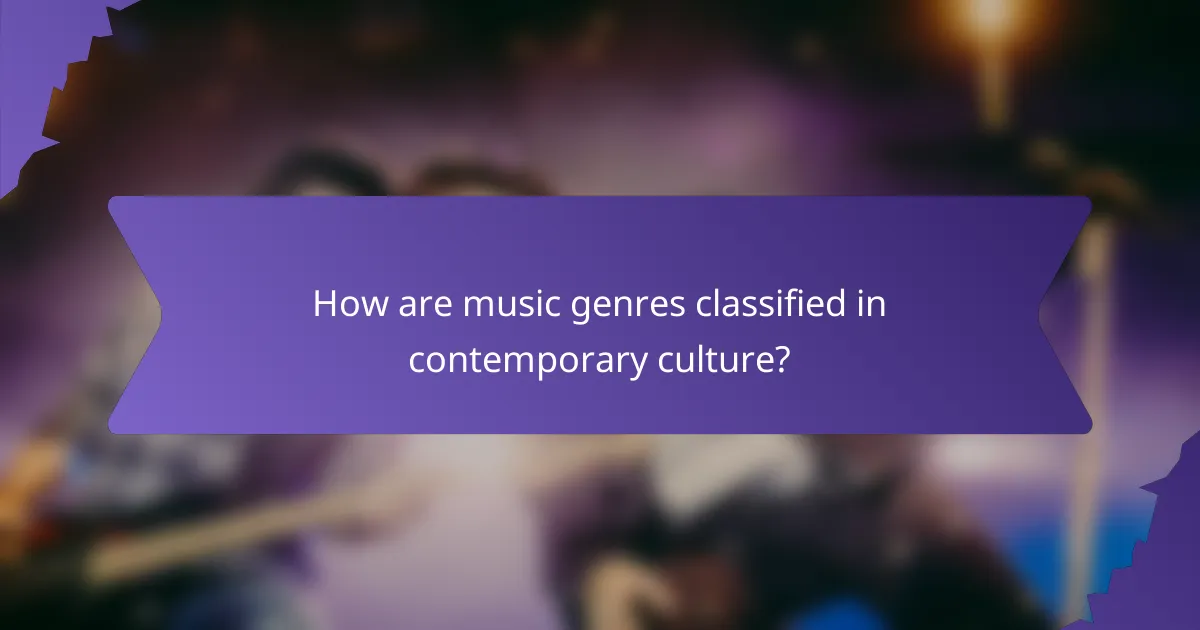
How are music genres classified in contemporary culture?
Music genres in contemporary culture are classified based on stylistic elements, cultural contexts, and audience reception. Genres evolve through influences from other styles, leading to hybrid forms. For example, pop music often incorporates elements from rock, hip-hop, and electronic music. The classification system reflects both historical roots and current trends, allowing for a dynamic understanding of music today. Unique attributes, such as regional variations and sub-genres, further enrich this classification, illustrating the complexity of musical identities.
What criteria are used to define music genres?
Music genres are defined by criteria such as musical style, instrumentation, cultural context, and lyrical themes. These attributes help categorize music into distinct genres, facilitating understanding and appreciation. For example, rock music often features electric guitars and a strong backbeat, while jazz emphasizes improvisation and complex harmonies. The evolution of genres reflects historical influences and cross-genre collaborations, showcasing the dynamic nature of music. Unique attributes, like regional variations, further enrich the classification system, highlighting the diversity within genres.
How do regional influences shape genre classification?
Regional influences significantly shape genre classification by introducing distinctive cultural elements. These influences manifest through local musical traditions, instruments, and social contexts that create unique sounds and styles. For instance, the incorporation of traditional African rhythms in American jazz exemplifies how regional characteristics can redefine a genre. Additionally, globalization facilitates cross-genre experimentation, allowing artists to blend regional styles with mainstream genres, further diversifying classifications. This dynamic interplay between regions and genres highlights the evolving nature of music classification, reflecting both cultural heritage and contemporary trends.
Which platforms are most popular for genre discovery?
Streaming platforms dominate music genre discovery. Services like Spotify, Apple Music, and YouTube provide personalized playlists and algorithm-driven recommendations. These platforms facilitate exploration through curated genre stations and user-generated content. Social media platforms such as TikTok also influence genre trends by showcasing snippets of songs, driving listener engagement.
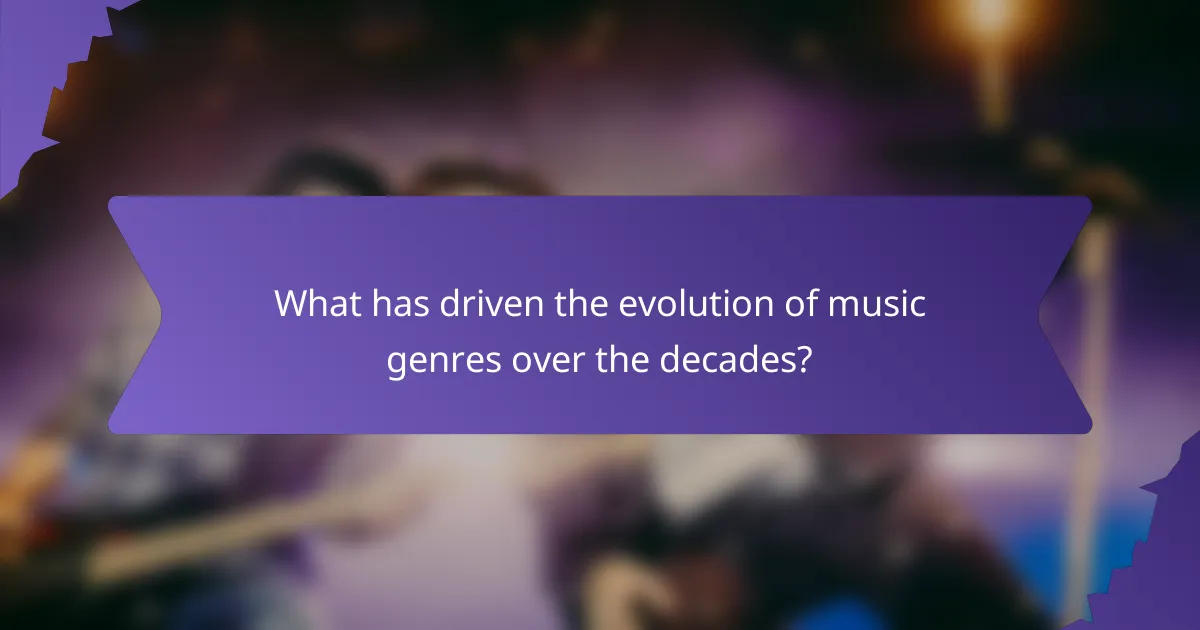
What has driven the evolution of music genres over the decades?
The evolution of music genres has been driven by cultural shifts, technological advancements, and cross-genre influences. Over decades, genres have adapted to societal changes, reflecting new ideas and emotions. Innovations like the internet have facilitated genre blending, leading to unique fusions. Additionally, globalization has allowed diverse musical styles to influence one another, creating hybrid genres.
How have technological advancements influenced genre development?
Technological advancements have significantly influenced music genre development by enabling new sounds and production techniques. Digital audio workstations and software synthesizers allow artists to experiment with diverse sounds, leading to the fusion of genres. Streaming platforms facilitate genre blending by exposing listeners to a wider range of music, encouraging cross-genre collaborations. Additionally, social media has democratized music distribution, allowing niche genres to gain popularity and evolve rapidly. These factors collectively reshape the landscape of music genres, promoting innovation and diversity.
In what ways have cultural movements shaped genre evolution?
Cultural movements have significantly influenced the evolution of music genres by introducing new ideas and styles. For example, the civil rights movement in the 1960s led to the rise of soul and funk, blending African American musical traditions with social messages. Punk rock emerged in response to political discontent, challenging the mainstream music industry. Additionally, the rise of hip-hop in the 1980s reflected urban culture and experiences, incorporating elements from various genres. These movements not only shaped genre characteristics but also fostered cross-genre collaborations, enriching the music landscape.
What role do music festivals play in genre transformation?
Music festivals significantly influence genre transformation by fostering collaboration and experimentation among artists. They create environments where diverse musical styles intersect, leading to innovative sounds. For example, festivals often feature a mix of genres, encouraging artists to blend elements, which can result in the emergence of new sub-genres. This cross-pollination enriches the music landscape, reflecting cultural shifts and audience preferences. As a result, music festivals serve as catalysts for genre evolution, showcasing how traditional boundaries can expand through communal artistic expression.
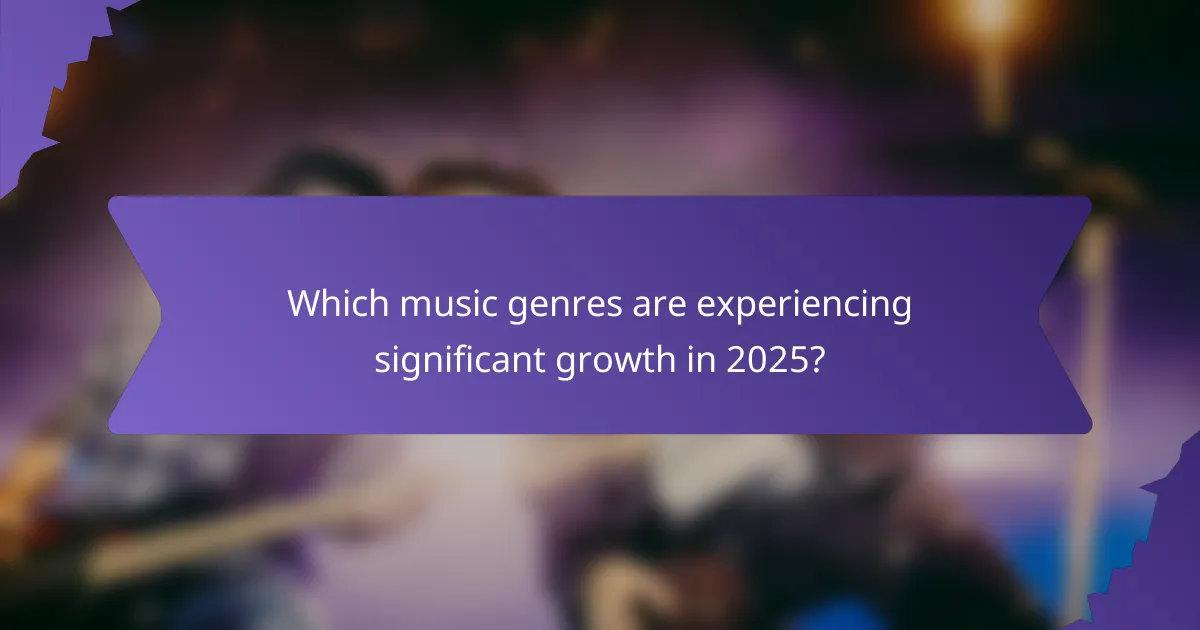
Which music genres are experiencing significant growth in 2025?
In 2025, genres like lo-fi hip hop, K-pop, and alternative R&B are experiencing significant growth. Lo-fi hip hop appeals to listeners seeking relaxation and study music, while K-pop continues to expand globally with its vibrant visuals and catchy tunes. Alternative R&B blends traditional and contemporary styles, attracting diverse audiences. These genres reflect evolving listener preferences and technological influences in music consumption.
What emerging genres are gaining traction globally?
Emerging music genres gaining traction globally include lo-fi hip hop, reggaeton, and K-pop. These genres reflect diverse cultural influences and innovative soundscapes.
Lo-fi hip hop blends chill beats with nostalgic samples, appealing to a relaxed audience. Reggaeton combines Latin rhythms with urban beats, creating a global dance phenomenon. K-pop showcases polished production and visual artistry, attracting a massive international fanbase.
As a result, these genres are reshaping the global music landscape, influencing mainstream sounds and cross-genre collaborations.
How do listener demographics affect genre popularity?
Listener demographics significantly influence genre popularity by shaping preferences based on age, culture, and socio-economic status. Younger audiences often gravitate towards pop and electronic genres, while older listeners may prefer classic rock or jazz. Cultural background also plays a crucial role; for instance, Hispanic audiences may favor reggaeton. Socio-economic factors can determine access to music platforms, impacting genre exposure. As a result, understanding these demographics helps artists and labels tailor their marketing strategies effectively.
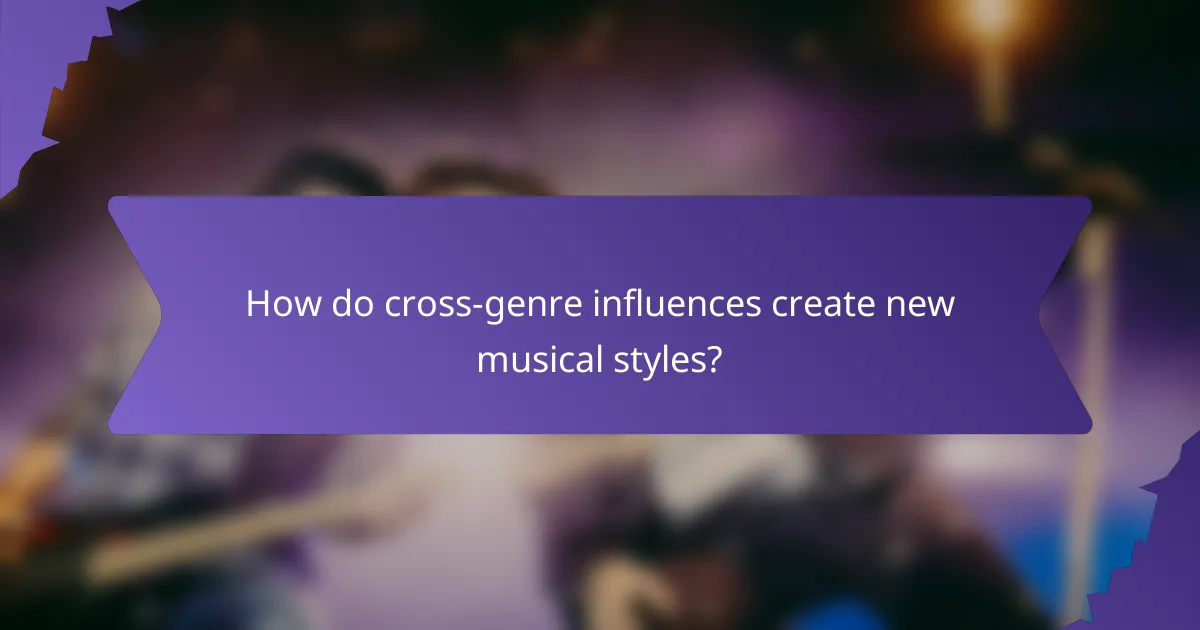
How do cross-genre influences create new musical styles?
Cross-genre influences create new musical styles by blending elements from different genres, leading to innovative sounds. This fusion allows artists to explore diverse rhythms, melodies, and lyrical themes, resulting in unique musical identities. For instance, the combination of hip-hop and rock has produced subgenres like rap-rock, showcasing how collaboration drives evolution. The emergence of genres like electronic dance music illustrates the impact of technology and cultural exchange on music’s transformation. Ultimately, cross-genre experimentation fosters creativity and expands the boundaries of musical expression.
What are some notable examples of successful genre fusion?
Successful genre fusion examples include notable collaborations and innovative styles. Genres like rock and hip-hop blend elements to create unique sounds. For example, Linkin Park fused nu-metal with hip-hop, resulting in a distinct musical identity. Similarly, the genre of country rap, popularized by artists like Lil Nas X, showcases a successful mix of country and hip-hop elements. Another example is the combination of electronic dance music with pop, seen in the works of artists like Calvin Harris. These fusions illustrate the evolving landscape of music genres and their cross-genre influences.
How do artists navigate multiple genres in their work?
Artists navigate multiple genres by blending elements to create innovative sounds and styles. This cross-genre approach allows for greater creativity and broader audience appeal. They often draw from diverse influences, which can enhance their music’s emotional depth and complexity. Unique collaborations with artists from different genres further enrich their work, leading to new musical forms and trends. The evolution of digital platforms also facilitates genre exploration, enabling artists to experiment and reach wider audiences.
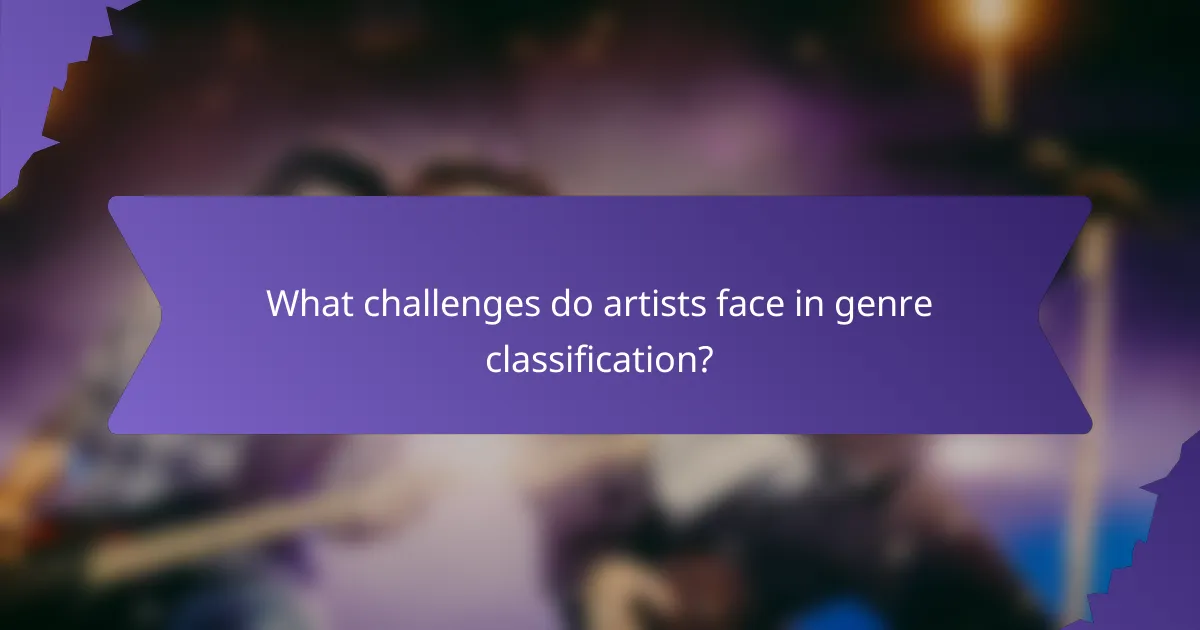
What challenges do artists face in genre classification?
Artists face significant challenges in genre classification due to evolving musical styles and audience perceptions. The fluidity of genres complicates traditional labels. Artists often blend influences from multiple genres, leading to ambiguity in classification. This cross-genre experimentation can create confusion for listeners and critics alike. Additionally, the rise of digital platforms has democratized music distribution, further blurring genre lines as niche styles gain visibility.
How does genre labeling impact artist marketing and audience reach?
Genre labeling significantly influences artist marketing and audience reach by defining target demographics and shaping promotional strategies. Accurate genre classification helps artists connect with listeners who share similar musical preferences. This connection enhances audience engagement and increases the potential for fanbase growth.
Moreover, genre labels can dictate the platforms and channels used for marketing. For instance, specific genres may thrive on particular streaming services or social media platforms. As a result, artists benefit from tailored marketing approaches that align with their genre identity.
Cross-genre influences can further expand an artist’s reach. By blending genres, artists can attract diverse audiences, enhancing their marketability. This evolution in genre perception allows for innovative collaborations and broader appeal, ultimately driving sales and streaming numbers.
In summary, genre labeling is a critical factor in shaping marketing strategies and audience engagement, impacting an artist’s overall success in the music industry.
What are the implications of genre fluidity for music consumption?
Genre fluidity significantly impacts music consumption by encouraging diverse listening habits and breaking traditional boundaries. Consumers increasingly explore cross-genre collaborations and hybrid styles, leading to a more expansive musical landscape. This evolution fosters greater artist creativity and enhances audience engagement. As a result, streaming platforms and social media amplify genre-blending, promoting niche genres and independent artists. The implications extend to marketing strategies as brands adapt to cater to diverse musical tastes, reflecting a shift in cultural consumption patterns.

How do music genres affect listener experiences and preferences?
Music genres significantly shape listener experiences and preferences by influencing emotional responses and cultural connections. Different genres evoke specific feelings; for instance, classical music often promotes relaxation, while upbeat pop can enhance mood.
Genres also reflect social identities, allowing listeners to connect with communities. The evolution of genres leads to cross-genre influences, enriching music diversity. For example, the fusion of hip-hop and jazz creates unique listening experiences, attracting varied audiences.
Preferences can shift based on exposure to different genres, impacting choices in social settings and personal enjoyment. Research indicates that familiarity with a genre increases its appeal, demonstrating the role of cultural context in shaping musical tastes.
What psychological factors influence genre preference?
Psychological factors such as personality traits, emotional responses, and social influences significantly shape music genre preference. For instance, introverted individuals may favor genres like classical or ambient music, while extroverts often prefer upbeat genres like pop or dance. Emotional connections to music can also drive preferences, as certain genres may evoke specific feelings or memories. Additionally, social identity and peer influence play crucial roles; people often choose genres that align with their social groups or cultural backgrounds.
How do social media trends impact genre engagement?
Social media trends significantly enhance genre engagement by shaping listener preferences and promoting cross-genre collaboration. Platforms like TikTok and Instagram facilitate the discovery of new music, allowing artists to reach wider audiences quickly. Viral challenges and trends can propel niche genres into mainstream popularity, influencing both the evolution of music styles and listener behavior. As a result, artists often blend genres to align with current trends, creating innovative sounds that resonate with diverse audiences.
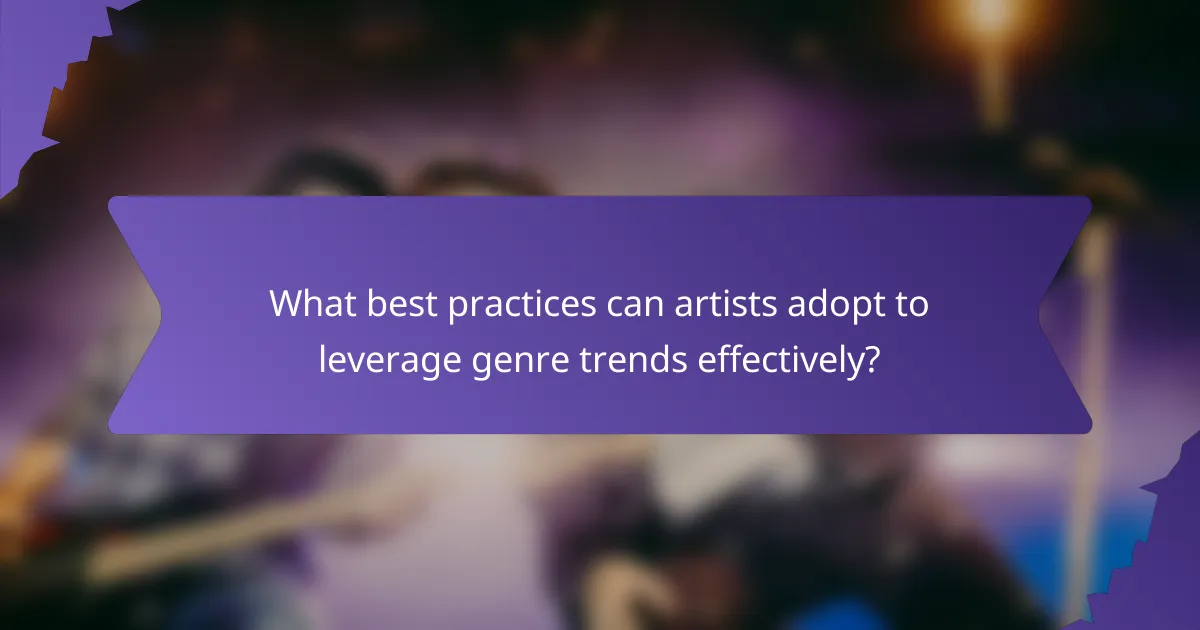
What best practices can artists adopt to leverage genre trends effectively?
Artists can effectively leverage genre trends by staying informed, experimenting with styles, and collaborating across genres. Understanding current trends enables artists to create relevant music that resonates with audiences. Experimentation allows for unique sounds, attracting diverse listeners. Collaborating with artists from different genres can lead to innovative blends, expanding reach and creativity. Engaging with fan feedback and utilizing social media can further enhance an artist’s adaptability to genre shifts.
How can artists identify and engage with their target genre audience?
Artists can identify and engage with their target genre audience by analyzing listener demographics and preferences. Understanding genre characteristics helps tailor marketing strategies effectively.
Utilize social media analytics to gauge audience interaction and preferences. Platforms like Instagram and TikTok provide insights into which genres resonate. Collaborate with genre-specific influencers to reach wider audiences.
Attend genre-related events to network and gain firsthand insights into audience behavior. Engaging directly with fans through live performances fosters loyalty and feedback.
Leverage streaming platforms’ data to refine music offerings based on listener trends. Monitor playlists and user-generated content to adapt to evolving audience tastes.
What strategies can be employed to innovate within established genres?
To innovate within established music genres, artists can blend elements from different styles, experiment with new technologies, and incorporate diverse cultural influences.
Cross-genre collaboration fosters creativity and introduces fresh sounds. For instance, combining electronic music with classical instruments can yield unique results.
Embracing technology, such as artificial intelligence and digital production tools, allows for novel compositions and soundscapes.
Additionally, drawing inspiration from global music traditions can enhance originality and appeal to wider audiences.
How can musicians collaborate across genres for creative growth?
Musicians can collaborate across genres to foster creative growth by blending diverse influences and techniques. This cross-genre interaction enhances innovation and broadens artistic horizons.
Collaborative projects often lead to unique sounds that attract wider audiences. For instance, a rock musician working with a jazz artist can create a fusion that retains the essence of both genres while introducing new elements. This approach not only enriches their individual styles but also encourages experimentation.
Moreover, genre-crossing collaborations can provide access to different fan bases. By engaging with musicians from various backgrounds, artists can reach new listeners and expand their market presence.
Ultimately, collaboration across genres cultivates an environment of creativity, allowing musicians to challenge conventions and explore new artistic territories.